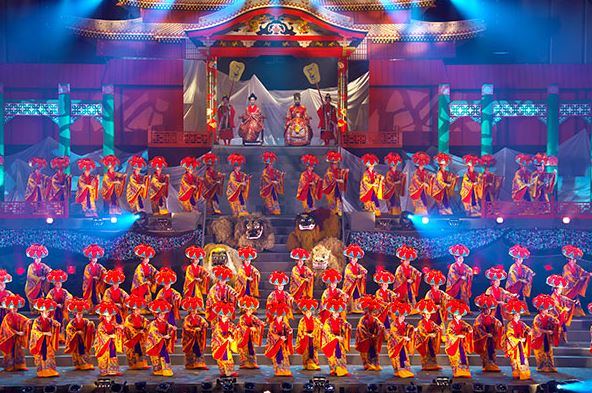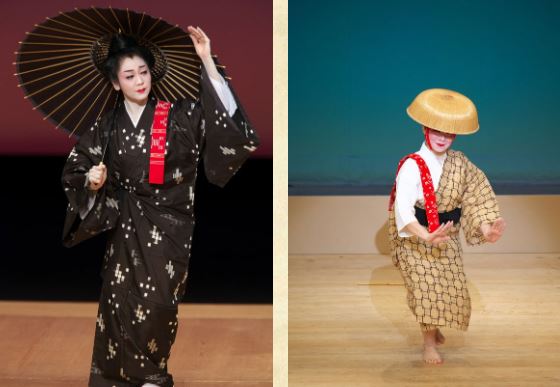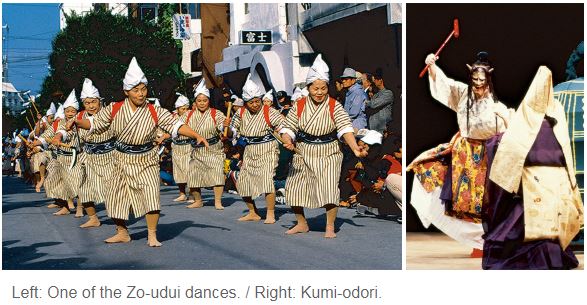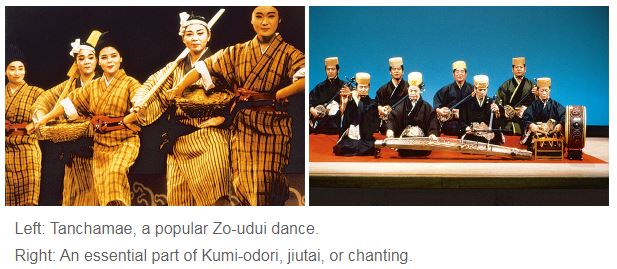
|
|
Ryukyuan Folk Dance
Published: Jan 24, 2020
|
Ryukyuan dance is a reflection of their culture and their talents. A kingdom of seafarers, fishermen and farmers enjoyed interaction with a variety of foreign lands including but not limited to Japan, Korea, China and other nations of Southeast Asia. The occasional visitor came to Ryukyu (Loo Choo, Liu Chiu, Lew Chew) from the Western world as well and influenced some of Ryukyu's observations and considerations of the world as a whole.
Their traditional and ritual dances demonstrate some of those interactions and interpretations. But mostly, Ryukyuan dance reflects typical life among the inhabitants of the Ryukyu Kingdom. Dance was of such great importance to Ryukyu that the king created the official position of Dance Minister. There are two types of Ryukyu dance: Classical (Court dance, or Koten-buyo) and Zo udui. The classic, called Ukanchin consists of four different kinds of dances. China and Ryukyu established formal diplomatic relations in 1404. For almost five centuries thereafter, a party of investiture envoys would be sent to Ryukyu by the Chinese emperor to authorize the accession of each new king. The Chinese ambassador would present a certificate of investiture formally recognizing the king’s status as ‘King of Ryukyu’ together with a royal crown. Since navigational conditions meant that the Chinese investiture parties had to stay in Ryukyu for several months, it was incumbent upon the royal government to provide them with hospitality which included banquets at which entertainments prompted the royal government in Shuri to devote much effort to patronage of the performing arts. Such were the conditions under which the genre of ‘classical dance’ developed. The ships which bore the Chinese envoys to Ryukyu were known as ‘crown ships’ (ukanshin), and the entertainments presented at the banquets held in honor of the envoys came to be referred to as ‘crown ship dances’ (ukanshinudui). Some Ryukyuan dance, kumi-odori, is the theatrical expression and arrangement of short songs handed down from generation to generation. Content is roughly split into two categories -- that of mundane topics such as romance, familial love, coming of age, etc., and that of violent revenge killing. The four styles of Ukanchin are Rojin, Wakashu, Onna, and Otoko. Rojin is an old folks' dance solemnly performed in respect for the aged. Wakashu is performed for young boys up to age 20 and features colorful costumes. Onna, a dance for women, is performed with slow easy movements. Facial expressions are important and the dance is sometimes, as in Yotsudake dance, accompanied with rectangular shaped castanets made with bamboo. Otoko, (or, nisai odori) men's dance, is fast and energetic. The traditional garb for Otoko dance is the bingata kimono.

Otoko / Nisai dance photo source: nt-okinawa.or.jp Amawari

photo source: oki-islandguide.com This dance depicts the tale of Amawari, a heroic adventurer and the lord of Katsuren Castle, who overcomes the socio-political upheaval of the unification of the Ryukyu period with the vigor and intensity of a typhoon. The two sons of Gosamaru, lord of Nakagusuku Castle, play the villains as they try to kill Amawari to avenge their father. |
Yotsutake

photo source: oki-islandguide.com Yotsutake is the most important classical dance in Okinawa. A woman dancing in a bingata kimono and a large red lotus hat is exactly what most Okinawans imagine when they think of Ryukyu dance. An integral part of classical women's dances, an extravagance of color and intricate designs serve as a symbol of Ryukyu culture. Yotsutake and other modern choreographies are relatively easy to see at places such as Shurijo Castle Park and also at local festivals and events, but Kumiodori is seen only at the National Theatre Okinawa, which is expected to become a traditional culture hub for the Asia/Pacific region, or at the Shurijo Castle Mid-Autumn Celebration, held annually in September. Through the music and dances, you will be able to catch a glimpse of the Okinawan soul.

Zo odori photo source: nt-okinawa.or.jp Zo udui (Zo odori) is the new style, or mixed style, of Okinawan folk dance which had its beginning during the late 19th century Meiji period and is based on everyday life in of the common people of Ryukyu. Prior to the dissolution of the Ryukyu Kingdom all performing arts were created and performed by and under the authority of the king's court at Shuri. After Ryukyu became Japanese Okinawa Prefecture the court lost its power and influence thus bringing about more contemporary artistic expression and thus Zo was born. The music is always played in quick tempo and is very rhythmic. They are often performed spontaneously during family celebrations, public occasions and even in the local izakaya once sufficient quantities of awamori have been consumed! The Ryukyuan performing arts have thus flourished in the ages of turbulent change, and a strongly distinctive traditional culture has emerged. No matter how difficult the conditions presented by history, there has been no decline in the creative will to give form to a culture of vivid beauty. One senses here the exceptional determination and farsightedness that enabled Ryukyuans of former times to come to terms with their historical situation.

photo source: oki-islandguide.com

photo source: oki-islandguide.com
References:
|
Video I shot at Shurijo in 2015
Yotsutake
From my visit to Ryukyu Mura in 2014
Just for fun....
©2020 Contact: ClickOkinawa.com
